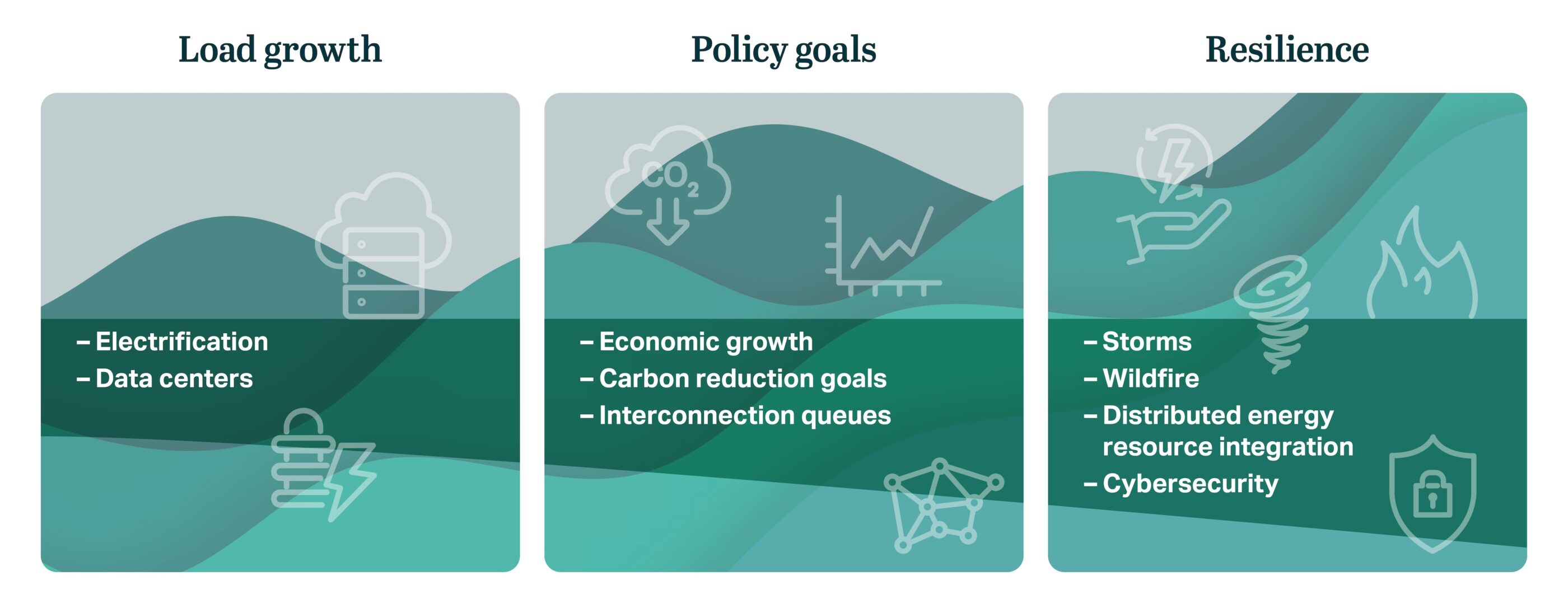With growing pressure on transmission and distribution, collaboration offers relief
Approximately half a million miles of transmission lines are spread across the United States today. Over the next 25 years, BloombergNEF predicts this number to more than double, enabling the interconnection of new generation and serving the rapidly growing energy demand. The country’s aging transmission and distribution infrastructure — most of it built in the ‘60s and ‘70s — must evolve to deliver the flexibility, reliability and resilience our modern society needs.
As a result, power utilities are challenged to think quickly about expanding capacity, advancing local policy goals and building resilience, all while electricity prices are rising faster than inflation and affordability is already a real concern for many Americans. Our U.S. climate advisory lead, Katrina Lewis, sat down with senior leaders from electric utilities across the country to discuss this era of challenging tradeoffs and the critical need for collaboration and strategic partnerships to navigate the evolving grid.
Keeping pace
The convergence of policy, skyrocketing energy demand and resilience investments are driving an unprecedented scale of investment and pace of execution that far outstrips that of years past. According to BloombergNEF, U.S. electric utilities are anticipated to invest over US$3.75 trillion in the grid over the next 25 years, more than any other country or region. As such, the involvement of all key stakeholders is required to thoughtfully plan, manage and execute this feat.

Utilities are anticipated to invest over US$3.75 trillion in the grid over the next 25 years
In response, we’re witnessing early pivotal utility rate cases in U.S. states like Ohio, where the tension between the need for growth and the impact on rate payers is being negotiated in real-time, potentially setting important precedents for other states. In various parts of the country, some stakeholders blame utilities for being too slow to keep pace with demand from new loads. Furthermore, utilities across the country are grappling with how to enhance resilience of the grid to natural disasters while maintaining affordability.
Key themes for electric utilities

We meet with a lot of our large customers in San Diego regularly and try to get their vision five to ten years out…We’re trying to get in front of it so we know where people [will] be, where the demand is going to be, [then] make investments, so we’re there ahead of time.
Will Speer, San Diego Gas & Electric, United States
Taking back control
Given the pace of change and the volume of demand growth, we offer an essential exploration of new partnership approaches for electric utilities:
1. Embrace evolving partnership models. Driven by the changing environment, utilities are having to manage programs to complete more work, faster, all while driving cost down to preserve affordability. At the same time, there is an increasing gap between available resources and skillsets needed to manage and deliver this work. Strategic partnerships are critical in securing a well-qualified workforce. Beyond resources, when partnerships are developed with suppliers who share common values, and who are willing to agree to be measured on shared objectives, that fundamental alignment and risk sharing helps motivate exceptional performance. This mitigates financial and technical risk and, ultimately, can be instrumental in helping utilities achieve their ambitious goals.
Case study:
An innovative partnership model: SDG&E Alliance
In 2022, AECOM began supporting San Diego Gas & Electric Company’s (SDG&E) Strategic Undergrounding Program, a critically important program that aims to reduce wildfire risk and improve electric safety and reliability during extreme weather conditions by burying power lines. The program uses an innovative program management structure in which every member of the team is measured by the success of the program overall. This One Team approach – which spans internal and contractor resources and has grown into a culture and way of working – has accelerated the pace of the undergrounding while reducing the cost per mile of work, helping to protect the people of San Diego.
2. Expand the scope and scale of proactive collaboration. Utilities have come a long way in evolving their planning frameworks to enable the timely interconnection of load and generation. However, with increasing electrification, there’s greater need for granular forecasting and a deeper understanding of adoption trends across customer classes and service territories to identify necessary upgrades. Utilities will need to embrace an industry-wide collaborative approach to better forecast and understand the impacts of building and vehicle electrification on the grid, municipal and state-level climate policies, and how all of this impacts our communities. In California, we’re seeing utilities changing the way they do long-term grid planning by collaborating with customers to develop a view on anticipated, rather than confirmed, future loads.
Collaboration and partnerships are important for us internally and externally. [we are] trying to really understand what customers and clients want.
Amber Young, Pepco Holdings, Inc., United States
3. Focus on program management excellence. Electric utilities aim to improve operational efficiencies and customer satisfaction and need to be thinking through risks and contingency planning to keep projects and programs on track despite the curveballs and challenges they’ll face. For some, this type of programmatic thinking and strategic risk management is already institutionalized within their capital programs teams. For others, program management consulting partners can help improve program/project delivery efficiency and outcomes by focusing on rigorous management of scope, schedule, cost, supply chain and risk. Taking the time to establish a thoughtful program/project management delivery partnership model can help utilities achieve impactful outcomes.
In order to keep pace and meet our goals, focusing on strong project and program management is key: what we do every day is risk management and contingency planning.
Patricia Lombardi, New York Power Authority, United States
A historic level of investment is being made to transform the energy grid. From new business, planning and forecasting to innovative program management approaches, electric utilities across the country are embracing proactive collaboration. The rapid energy transition requires industry-wide partnerships for long-term success. By breaking out of well-defined patterns, electric utilities can overcome the building pressures and effectively navigate today’s utility and policy landscape.






